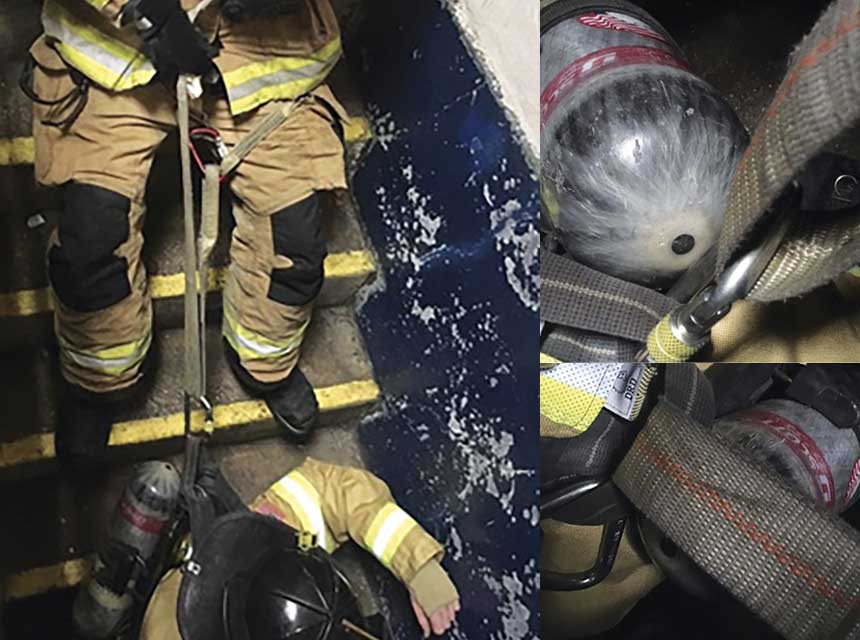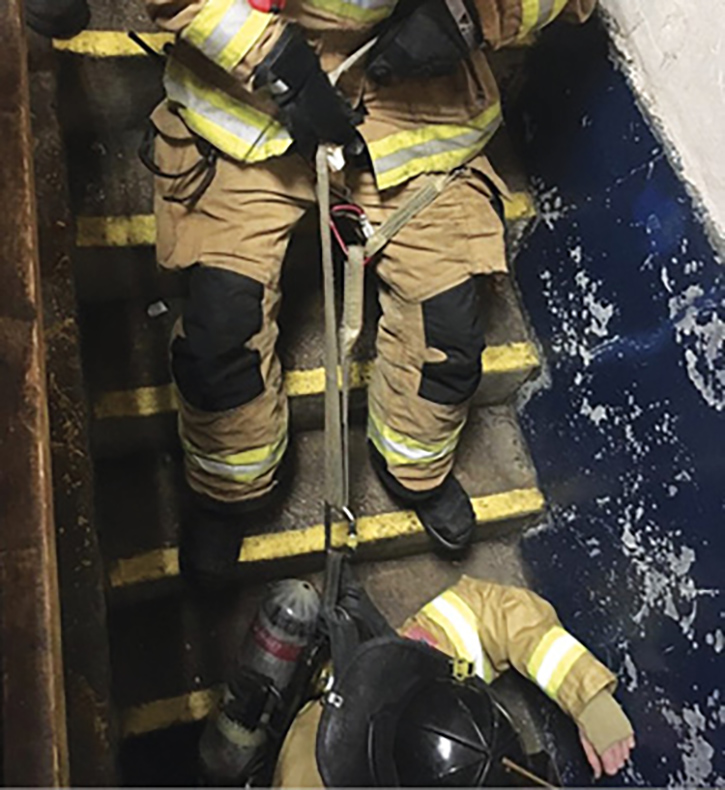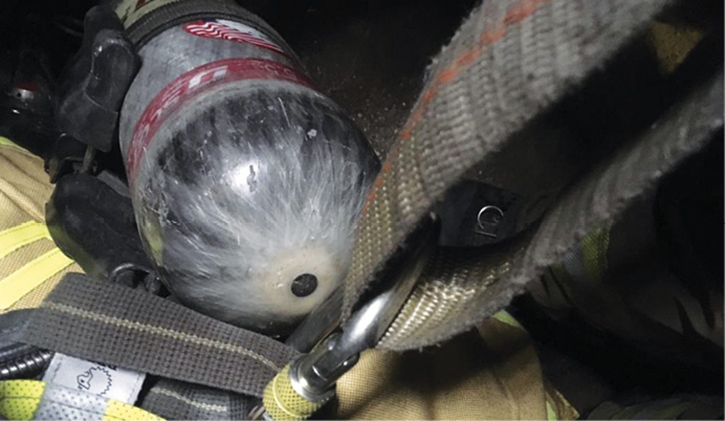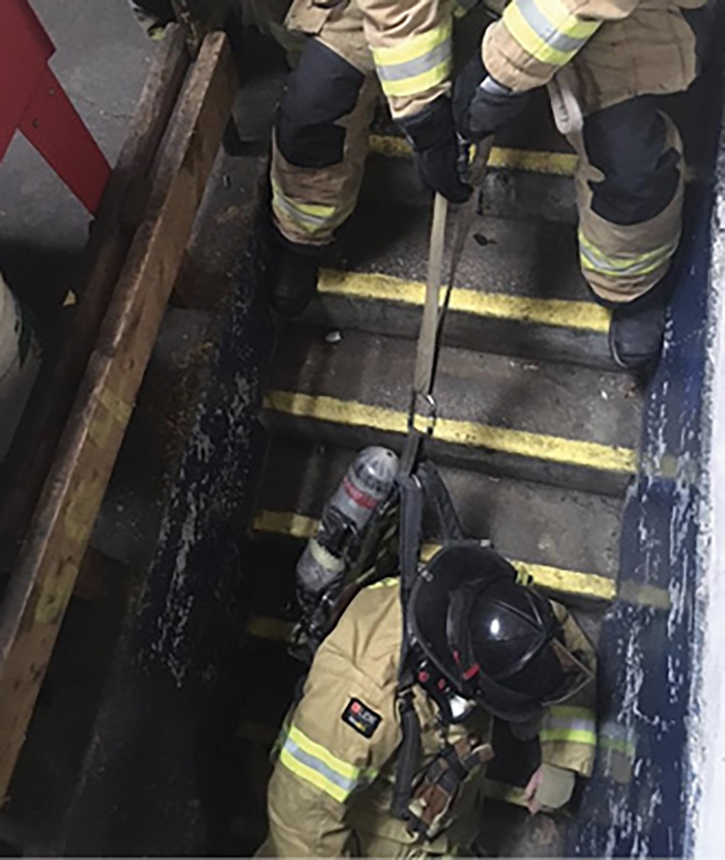
It is dangerous to overestimate our ability to move a down person single-handedly any distance. It is equally perilous to underestimate the environment in which we have to do it. Up the stairs, down the stairs, across a hall—we must be prepared to move a victim anywhere that is away from the punishing conditions. A rapidly changing, immediately dangerous to life or health (IDLH) environment necessitates speed. Consider the simple maneuver below that can aid us in partial or total removal of a victim from an unforgiving environment—quickly.
Moving a Firefighter
Imagine that you and your partner are conducting a search semi-belowgrade as the engine crew gets a stranglehold on the fire. Very close to the entryway, your partner goes down. You do all the right things: You ensure he is breathing and has air, and you initiate emergency radio traffic to identify your location, unit, and condition. However, heavy radio traffic for the attack is stepping on and breaking up your message; reception from the basement is spotty at best. How can you move your partner up the stairs speedily and out of the IDLH? Or move a down person who is at the bottom of the cellar stairs on your descent? These situations require immediate action.
RELATED FIREFIGHTER TRAINING
Creative Thinking in Technical Rescue
Odd Mechanical Advantage Rope Systems with Progress Capture
Training the Technical Rescuer
Although there are numerous ways to accomplish this, one worth noting is simple, expedient, and tailored toward enabling the movement of a sizable weight while keeping the firefighter’s self-contained breathing apparatus (SCBA) secured: creating a simple 2:1 mechanical advantage system (MAS) with virtually no equipment. In a matter of seconds, fully gloved, geared, and ready to move, you need to be prepared to essentially halve the load that you will be moving. For this, I recommend a mid-length strap (no more than 10 feet long) that is about as wide as the palm of your hand with two reinforced handles. Personal webbing will work in this instance; however, unrolling and manipulating thinner fabric can be difficult. Also, if the webbing knots or rolls over on itself, it may be difficult to pass through your “pulley.”
Using PPE Rescue Systems
Most of today’s firefighters have some sort of bailout system affixed to a two-point seat harness in their personal protective equipment (PPE). Whatever system is used, it generally has a clip or carabiner in the waist, and you can quickly use it to create a mechanical advantage. Also, most PPE are outfitted with a drag rescue device (DRD) at the collar—better still, a drag loop on the SCBA. To quickly create your 2:1 MAS here, all the rescuer needs to do is affix one end of his strap to his bailout carabiner and run the other end through the DRD or SCBA drag loop of the victim (photos 1-3). An extra carabiner will yield big rewards here. If you can take a second and affix it to either the DRD or loop and run your strap through it, the strap will slide much more easily (photo 4). By positioning yourself behind the down member and stepping backward, you let some of the strap run; keeping the body upward, you can pull the strap and the victim toward you. For those familiar with any rope work, you are mirroring the action of a simple pickoff strap (without load capture), but instead of taking all of the victim’s weight on your harness, at least a portion of it will be distributed along the ground. In that sense, it is a 2:1, but you are not really lifting all the weight. You are moving, not lifting. Getting a dead weight up the stair in this fashion is fast, relatively easy, and simple to set up.

(1)

(2)

(3)
However, it is still a tough execution. The victim’s SCBA bottle may catch on the stair tread nosing, the victim may become entangled, and all of the other risks that come into play when moving an unconscious person are still present. Snagging his PPE on debris and accidentally dislodging the SCBA mask are two instances that come to mind. Effecting a clean drag is meaningless if the air supply is cut off. That is why the strap must be no longer than 10 feet. If you have to descend to move the victim around a bit (e.g., maneuver the person around a piece of debris or over a tread that is catching the bottle), you can’t afford to be too far away.
If the environment allows, you should take a minute and run the down member’s waist strap under his leg for extra security. If in your experience it is quicker to use additional webbing to lash the victim across the chest and under the legs, do so. However, tightening shoulder straps and manipulating the affixed waist straps are not difficult. Use your judgment.
A good tip: Run the waist strap under the victim’s left leg. It may help the victim to lean slightly to the right when raising, thus keeping his airline in free space and his bottle valve farther away from the stair (photo 5). Tighten all the straps if you have the time; but, again, skip it if you have to.

(4)

(5)
Another quick tip: Rather than lift the legs to manipulate the strap, you can simply unbuckle the waist strap, pass it through the victim’s bailout harness carabiner, and reclip it. This will provide the same measure of security.
Moving Civilian Victims
You can move a civilian up the stairs similarly. The only addition is some means of strapping the victim around the chest area and under the arms—a rescue sling, a length of webbing, a small length of rope, anything. A second identical strap to the one you are using is great—that is, if you have judged correctly your inability to initiate a move without using any advantage. Again, it has to be fast. How fast can we get this person away from this area?
Imagine encountering a sizable, morbidly obese, or bariatric person down in a hallway that is about to be overrun. Yes, summon help. Yes, try to do a collar drag or get the victim under a sheet. Depending on the person’s size and the things in the environment that are immediately available (e.g., a door onto which you can roll the victim, a chair that you can slide under the victim), your initial tug may yield no result at all. If so, can you get this victim across the hall and behind closed doors in under 30 seconds with limited visibility? With this simple 2:1 MAS, you probably can. You use it the same way, with the rescuer seated or crouched at the victim’s head, and scoot across the floor, resetting when needed, and get the person behind a barrier. Emergency radio traffic, keeping the victim in refuge, or setting up removal can follow.
Remember: When time allows, there are many things you can do. You can create a 3:1 MAS with your bailout system, plan to grab multiples, await an additional member to help you move, put the member in a Swiss seat, and so on. But, you have to accurately assess your ability to move a down person immediately when simple brute force won’t do it.
Another example where this simple advantage comes in would be getting a member or victim up to a window for fresh air. With no tools to brace the person or furniture to slide under the victim, you can set this up, straddle the victim, raise, get the victim close to that sill, and push the rest of the way. It is a good way to set someone up for removal from a ground ladder. The higher you can get your waist above the windowsill, the better. If there is something close by to stand on, use it.
Controlled descent can work in the same manner. Getting a large victim or firefighter down the stairs on your own is demanding. In an extreme case, getting in front of the member and letting gravity help you is very acceptable. However, if trying to ensure that the SCBA stays secure, the victim stays controlled, or a very large person does not come down on top of you, the waist-based 2:1 MAS will work. Again, set it up quickly, get set behind your victim, get your legs under his back, keep the strap cinched, and lower. Descend to the victim’s location, and repeat. It works remarkably well.
Be prepared to do what you can accomplish all of the time. All of the fancy wrapping and advantages are useless if you cannot put them into action under duress. That is the reasoning behind using a thick-handled strap as opposed to webbing or rope. When you are smoked out and hot, grabbing personal rope from your pocket or a length of webbing can be difficult with your gloves’ limited dexterity. Also, trying to loop it through the down member’s back loop or carabiner can be hard to do. A stiff-ended strap is superior here. You can grab it quickly, it will not bunch up under deployment, and it will loop through nicely. Rolled up over itself, it fits neatly in your bunker gear pocket. I don’t advocate replacing one’s personal rope or webbing, but a thick strap with two handles lends itself well to facilitating quick drags, making fast tool loops, and (if rated) serving as anchor straps.
We must be able to obtain mechanical advantage over a load as quickly as the emergency environment can change. We can take more time if it is changing slowly. Unfortunately, today’s rescue areas can go from tenable to unbearable in seconds. We can use most of our self-rescue systems designed for rapid intervention in a similar fashion to move, raise, lower, and perform other maneuvers. Although they are not nearly as quickly set up, when a 2:1 MAS is not enough, we need to be fluent in using the back end of our bail lines to create fast 3:1, 4:1, and lowering systems. We must be ready to increase advantage if the situation calls for it. Recognizing when advantage must be increased and transitioning to it are subjects for another day. That said, we need to operate from a position of speed. Completing the rescue with the smallest amount of advantage needed is paramount.
This technique provides instantaneous, user-friendly, and fast mechanical advantage. It is a step above simple drags but a step below more complex rapid intervention team maneuvers. Although not all responders are muscular, nobody can be left behind. We often cannot see. People are heavy. Firefighters are heavier. Sometimes, all you need to do immediately is to move a member or civilian 10 feet to an adjacent room, a bend in the stairs, or the next landing. With this maneuver, you can get the potential victim out of the IDLH environment until additional help arrives, or you can reset and repeat this a multitude of times for total extraction.
You need to be as competent at single-handedly moving a life as you are at all of your other fire tasks, perhaps more. Cutting in half the weight you have to move can help. Practical practice, diligence, and familiarity with your complement and skill set will give results.
There is no better method of moving dead weight than having additional personnel with you. Even the most antiquated two-person maneuver can be superior to a single-person move. That is one of the many reasons we need to stick together.
ALEXANDER DEGNAN is a captain in Squad Co. 4 of the Jersey City (NJ) Fire Department, where he has served since 2005. Squad 4 is an engine company assigned to the 4th Battalion and also responds to every fire assignment throughout the city.

